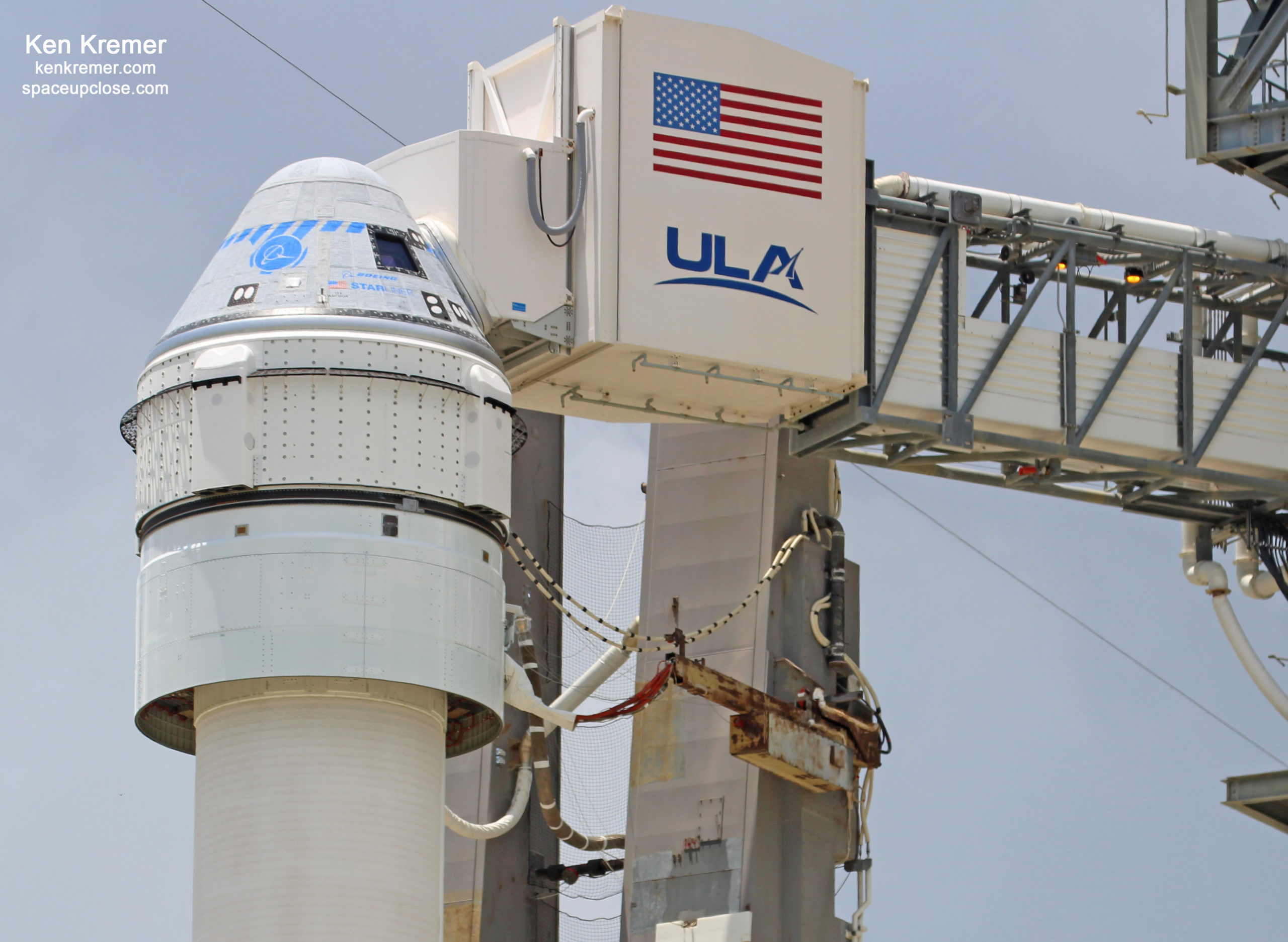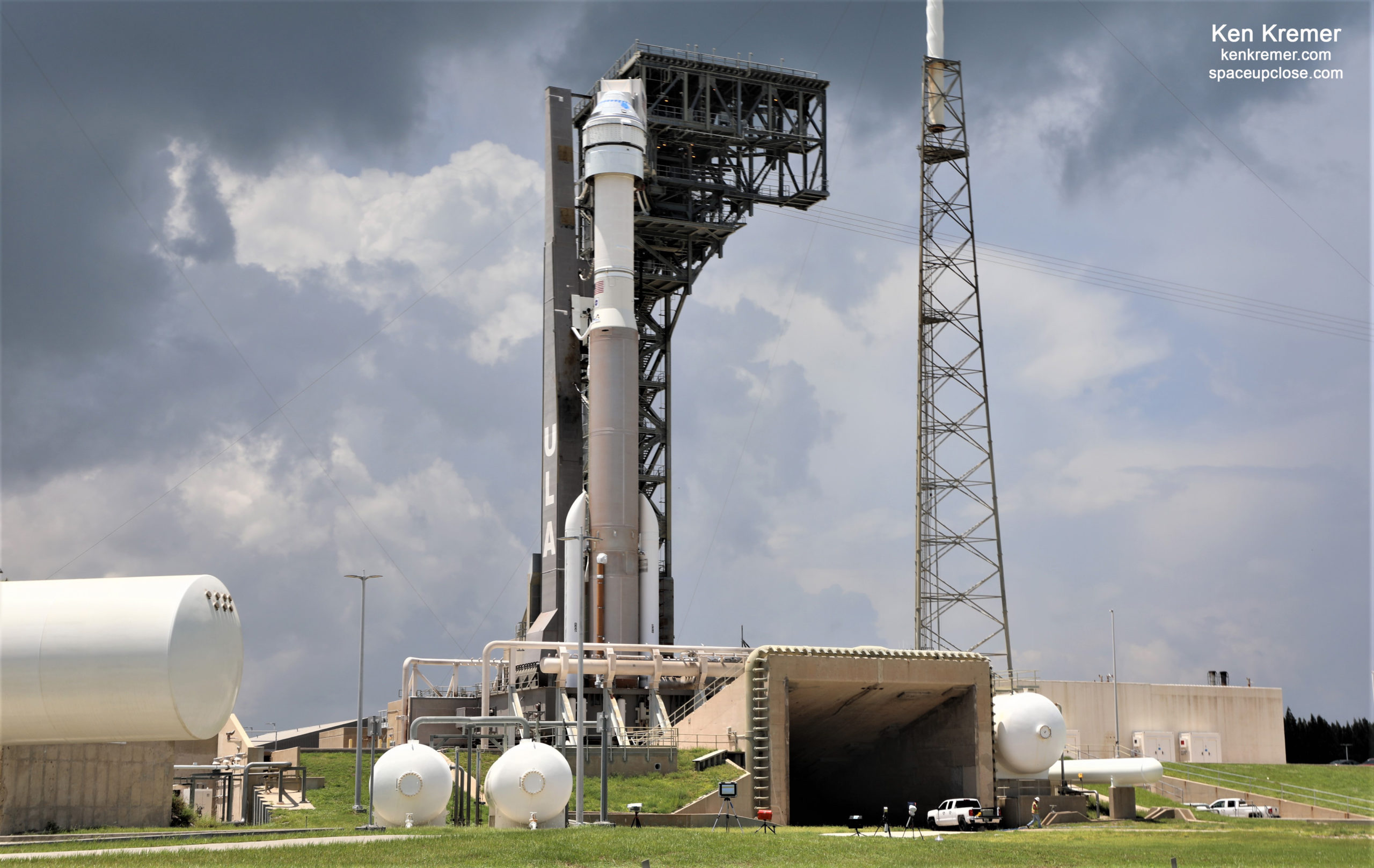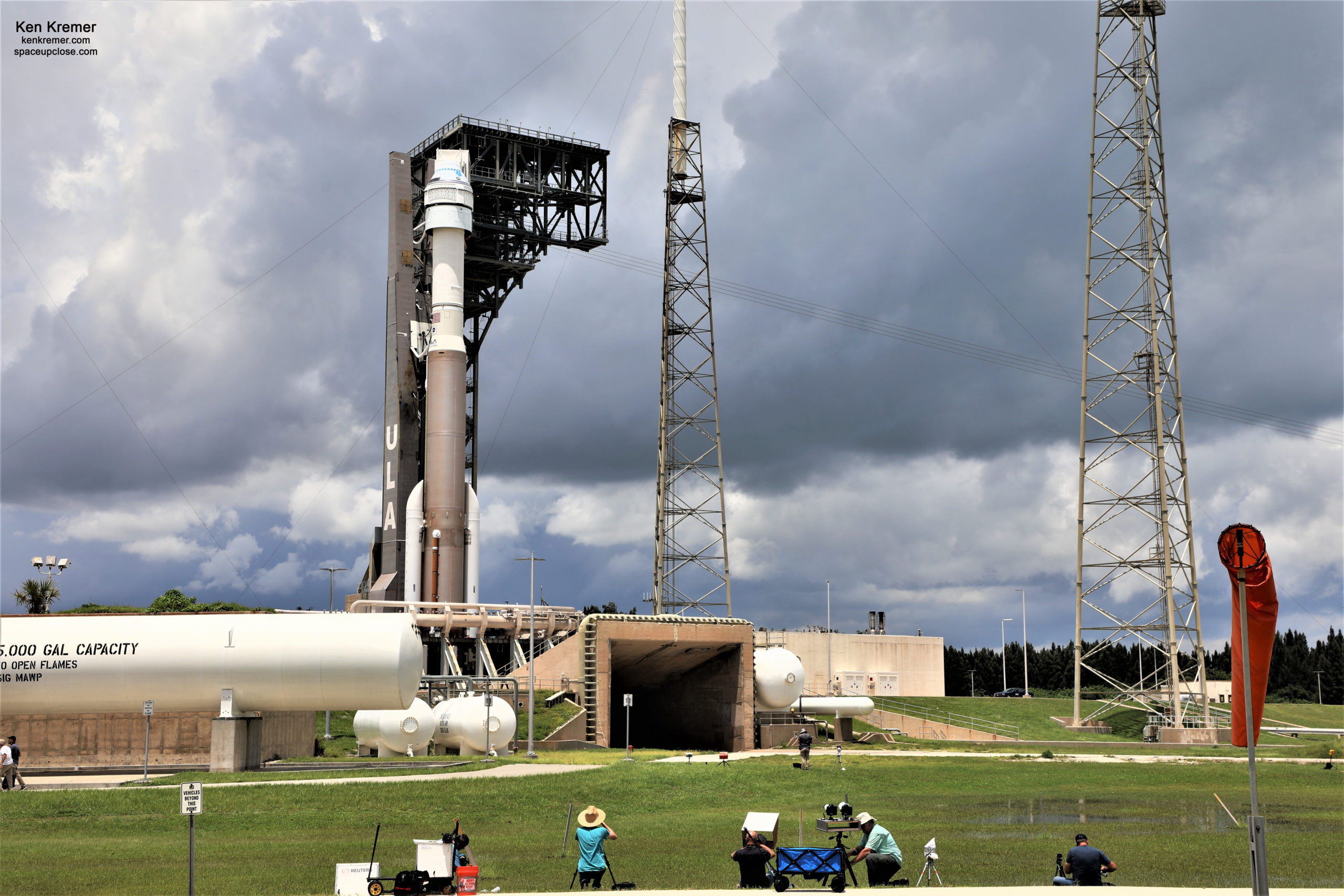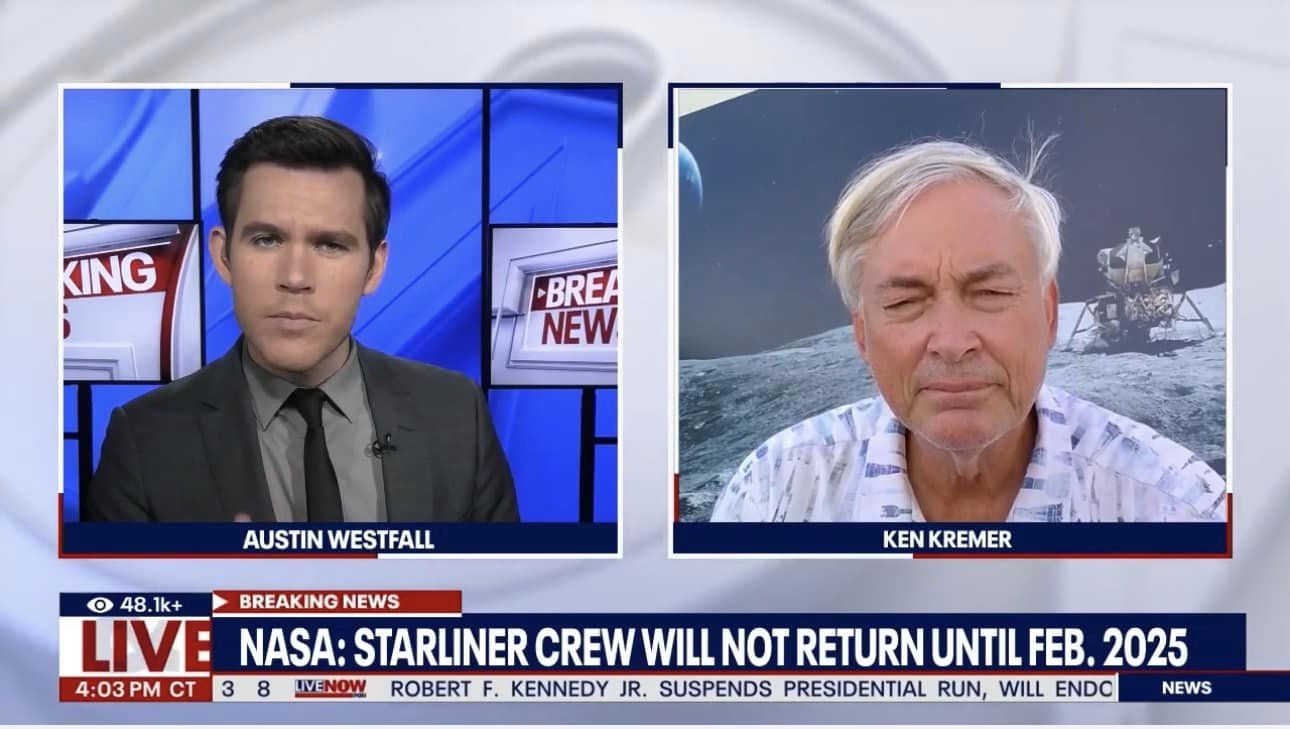
For SpaceUpClose.com & RocketSTEM
CAPE CANAVERAL, FL – NASA has postponed the next launch attempt of the oft delayed Boeing Starliner uncrewed test flight into no earlier than the first half of 2022 as engineers continue to search for the root cause and fix the faulty propulsion valves discovered inside the spaceships service module that forced a scrub during the Aug. 3 countdown attempt this past summer.
The latest liftoff attempt for the uncrewed Orbital Flight Test-2 (OFT-2) mission to the International Space Station (ISS) had been slated for late July/early August timeframe until 13 oxidizer propulsion valves on the Starliner service module were found to be stuck and could not be moved after heavy periods of rain impacted the Starliner poised atop a ULA Atlas V rocket at launch pad 41 during the Aug. 3 launch attempt ultimately scrubbed.
After days of round-the-clock intense effort at the pad in August Boeing and NASA teams concluded that the severity of the needed repairs to restore full functionality and the ongoing search for a definitive root cause could only be done by destacking of the Starliner astronaut ferry ship from atop the United Launch Alliance (ULA) Atlas V rocket and rolling it back to the manufacturing facility at NASA’s Kennedy Space Center in Florida, officials announced at a news media briefing Aug. 13.
As troubleshooting and the search for root cause continues Boeing says the most probable cause is related to interactions of moisture and nitrogen tetroxide oxidizer.
As a result the launch of the Boeing Starliner astronaut ferry ship on the OFT-2 test flight on what amounts to a redo mission for NASA to the ISS was indefinitely postponed at that time and now further postponed into next year – amounting to over a 2 year delay from the original botched OFT mission in Dec. 2019.
“The NASA, Boeing team continues to make progress on the investigation of the oxidizer isolation valve issue on the Starliner service module propulsion system that was discovered ahead of the planned uncrewed Orbital Flight Test-2 (OFT-2) mission to the International Space Station in August,” NASA announced in an Oct. 8 statement.
“Potential launch windows for OFT-2 continue to be assessed by NASA, Boeing, United Launch Alliance, and the Eastern Range. The team currently is working toward opportunities in the first half of 2022 pending hardware readiness, the rocket manifest, and space station availability.”
The Boeing Starliner is part of NASA’s Commercial Crew Program (CCP) to restore human spaceflight launch capabilities to the US and end total reliance on the Russian Soyuz crew capsule.

To date all but one of the 13 stuck thrusters valves has been successfully commanded by Boeing engineers to move – but using extraordinary techniques such as using localized heating and electrical charging techniques.
One of the 13 valves has been left in its unmoved stuck state to enable further forensics and continue root cause analysis.
“That valve has not been moved intentionally to preserve forensics for direct root cause analysis,” said NASA.
Now after months of effort since the scrub, a definitive solution continues to remain elusive as Boeing engineers continue to troubleshoot the thruster problems along the fault tree related to avionics, flight software, wiring and more.
“I am proud of the work our integrated teams are doing,” said Steve Stich, manager of the Commercial Crew Program at NASA’s Kennedy Space Center in Florida, in the Oct. 8 statement.
“This is a complex issue involving hazardous commodities and intricate areas of the spacecraft that are not easily accessed. It has taken a methodical approach and sound engineering to effectively examine.”
Starliner failed to dock on the inaugural problem plagued original Orbital Flight Test (OFT) mission in Dec. 2019 due to a host of software and hardware issues with the capsule.
Boeing spent 18 months working to fix Starliner and implemented some 80 recommendations from NASA and an Independent Review Board following the OFT flight failure to reach the ISS.

Depending on how long it takes for the valve fixes to be made and verified and furthermore finding an opening in the busy schedule of visiting vehicles to the ISS results in a NET 2022 launch window.
Even it if were ready today – which it is not – Starliner would have to wait months at a minimum because of other higher priority launches like NASA’s Lucy mission to investigate Trojan asteroids launching on another ULA Atlas V on Oct. 16.
The immutable launch window for the higher priority Lucy probe runs to Nov. 5.
Starliner will also have to wait until after the SpaceX Crew 3 launch slated for Oct. 30 and the return of Crew-2 in early November 2021 in order to free up one of only two available docking ports on the ISS
Another SpaceX Cargo Dragon is slated for liftoff for NASA to the ISS in late December this year.
Thereafter Crew 4 will launch in mid-April 2022 in addition to continuing additional cargo resupply missions from Northrop Grumman and SpaceX

Options available to Boeing include fixing/refurbishing the current service module or swapping out to a new service module – with any thruster valve fixes. They are disposed after each mission upon separation during the reentry phase of flight.
“Boeing has identified a most probable cause related to oxidizer and moisture interactions, and although some verification work remains underway, our confidence is high enough that we are commencing corrective and preventive actions, said NASA. “
“Additional spacecraft and component testing will be conducted in the coming weeks to further explore contributing factors and necessary system remediation before flight.”
“Boeing completed a partial disassembly of three of the affected Orbital Maneuvering and Attitude Control (OMAC) thruster valves last month and plans to remove three valves from the OFT-2 spacecraft in the coming weeks for further inspection. The team also is evaluating additional testing to repeat the initial valve failures.”
“Boeing has identified several paths forward depending on the outcome of the testing to ultimately resolve the issue and prevent it from happening on future flights. These options could range from minor refurbishment of the current service module components to using another service module already in production. Each option is dependent on data points the team expects to collect in the coming weeks including a timeline for safely proceeding back to the launch pad.”
 Up Close look at Boeing CST-100 Starliner spacecraft perched atop United Launch Alliance (ULA) Atlas V rocket after rollout for launch of the Orbital Flight Test-2 (OFT-2) test flight for NASA to the International Space Station (ISS) on Aug. 3, 2021 from Space Launch Complex-41 on Cape Canaveral Space Force Station, Florida. Credit: Ken Kremer/kenkremer.com/spaceupclose.com
Up Close look at Boeing CST-100 Starliner spacecraft perched atop United Launch Alliance (ULA) Atlas V rocket after rollout for launch of the Orbital Flight Test-2 (OFT-2) test flight for NASA to the International Space Station (ISS) on Aug. 3, 2021 from Space Launch Complex-41 on Cape Canaveral Space Force Station, Florida. Credit: Ken Kremer/kenkremer.com/spaceupclose.com
The goal of OFT-2 mission is to test the end-to-end capabilities of Starliner from launch to docking, atmospheric re-entry, and a desert landing in the western United States.
OFT-2 will provide valuable data that will help NASA certify Boeing’s crew transportation system to carry astronauts to and from the space station.
NASA’s other Commercial Crew Program (CCP) partner SpaceX has already successfully launched three crews of astronauts to the ISS since May 2020.
Boeing will fly this second uncrewed Starliner mission OFT-2 at their own expense of some $420 million on an Atlas V that was targeting liftoff Aug. 3 to prove to NASA the vehicle is safe and reliable.
OFT-2 is the last flight before the Starliner system launches American astronauts on the Crew Flight Test to the microgravity laboratory – the first flight test with crew on board.
If all had gone well with OFT-2 a trio of NASA astronauts were to fly on the first crewed Starliner mission dubbed CFT (Crew Flight Test) perhaps as soon as years end – if Starliner had launched soon.
The CFT crew launch is now indefinitely postponed to later 2022
ABC 9 News Orlando featured my commentary and analysis about more delays for Boeing Starliner OFT-2 test flight on Sept. 22/23
Ken reported onsite from the Kennedy Space Center and Cape Canaveral Space Force Station for the Starliner mission.
Watch Ken’s continuing reports about ISS, Starliner and Commercial Crew and Crew Dragon, Artemis and NASA missions, SLS, Orion, SpaceX, Starlink from onsite for live reporting of upcoming and recent SpaceX and ULA launches including Crew 1 & 2, Demo-2, ISS, X-37B, Solar Orbiter, Mars 2020 Perseverance and Curiosity rovers, NRO spysats and more national security missions and more at the Kennedy Space Center and Cape Canaveral Space Force Station.
Stay tuned here for Ken’s continuing Earth and Planetary science and human spaceflight news: www.kenkremer.com –www.spaceupclose.com – twitter @ken_kremer – email: ken at kenkremer.com
Dr. Kremer is a research scientist and journalist based in the KSC area, active in outreach and interviewed regularly on TV and radio about space topics.
………….
Ken’s photos are for sale and he is available for lectures and outreach events
Please consider supporting Ken’s work by purchasing his photos and/or donating at Patreon:
https://www.patreon.com/kenkremer
x



